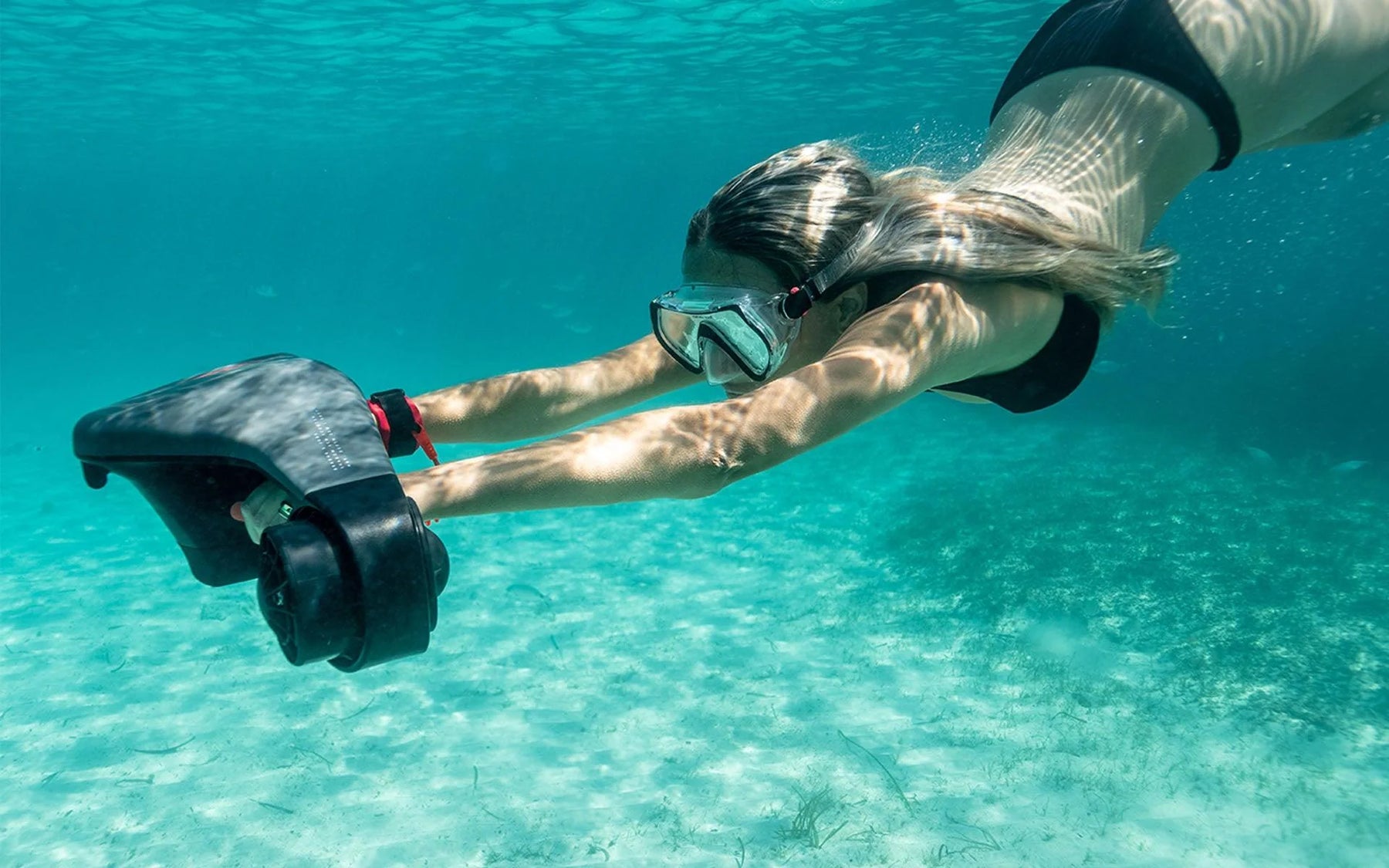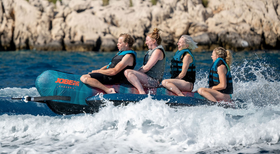
The Ultimate Guide to Sea Scooters: Everything you need to know
What are Sea Scooters?
Sea scooters, also known as underwater propulsion vehicles (UPVs) or diver propulsion vehicles (DPVs), utilise a combination of advanced technologies to provide propulsion and enhance underwater mobility.
Let’s take a look at some key design features:

Electric Motors: Most modern sea scooters are powered by electric motors, which offer several advantages over traditional combustion engines, including quieter operation, lower emissions and easier maintenance. These motors are typically powered by rechargeable lithium-ion batteries, providing a reliable and efficient power source for underwater propulsion.
Propellers: Sea scooters use one or more propellers to generate thrust and propel the device through the water. The size and design of the propellers can vary depending on the intended use and performance requirements of the sea scooter. High-performance models may feature multiple propellers for increased speed and manoeuvrability.
Variable Speed Control: Many sea scooters are equipped with variable speed control mechanisms, allowing users to adjust the propulsion force and speed of the device to suit their preferences and the specific conditions of the underwater environment. This feature enables precise control over acceleration and deceleration, as well as the ability to conserve battery power when necessary.
Buoyancy Control: Some sea scooters incorporate buoyancy control systems to help users maintain their desired depth and buoyancy while underwater. These systems may include adjustable ballast weights, buoyancy chambers or hydrodynamic fins that help stabilize the scooter and counteract changes in buoyancy caused by changes in speed or depth.
Lightweight Construction: Sea scooters are typically constructed from lightweight materials such as plastic, aluminium or composite materials, which help reduce overall weight and increase buoyancy. This makes them easier to handle and manoeuvre underwater, as well as more portable and convenient to transport to and from dive sites.
Ergonomic Design: The design of sea scooters often incorporates ergonomic features such as streamlined shapes, comfortable handles and intuitive control interfaces to enhance user comfort and usability. These design elements help reduce fatigue and strain during extended underwater excursions, allowing users to focus on enjoying their diving or snorkelling experience.

Overall, sea scooters employ a combination of electric propulsion, advanced control systems and ergonomic design to provide users with a convenient and efficient means of underwater transportation. By harnessing these technologies, sea scooters enhance the enjoyment and accessibility of underwater exploration for divers, snorkellers and water sports enthusiasts.
A bit about the history of Sea Scooters
The concept of using propulsion devices to assist divers dates back to the early 20th century. Various inventors and engineers began experimenting with different designs and propulsion methods. However, early prototypes were often cumbersome and inefficient, limiting their practicality and widespread adoption.
During World War II, several countries began developing underwater propulsion devices for military divers, such as the Italian 'human torpedo' below (also known as the maiale), primarily for use in reconnaissance and sabotage missions. These early DPVs were often simple, hand-operated devices powered by compressed air or small combustion engines.

[The Italian maiale, at the Royal Navy Submarine Museum in Gosport, Hampshire, South East England]
In the 1960s and 1970s, the first commercially available sea scooters began to emerge, primarily targeting recreational divers and underwater enthusiasts. These early models typically featured electric motors and rechargeable batteries, offering improved reliability and ease of use compared to earlier designs.
In recent decades, advancements in battery technology, electric motors and materials led to significant improvements in the performance, reliability and affordability of sea scooters. Modern sea scooters are now lighter, more compact and more powerful than ever before, making them accessible to a wider range of users.

In addition to recreational diving, sea scooters have found applications in various other fields, including underwater photography, marine research, search and rescue operations as well as military and law enforcement activities. Their versatility and manoeuvrability make them valuable tools for exploring underwater environments and conducting underwater tasks more efficiently.
Today, the market for sea scooters continues to grow, with numerous manufacturers producing a wide range of models to suit different budgets and user preferences. Recent advancements include features such as variable speed control, integrated buoyancy control systems and improved battery life.
From humble beginnings as military tools to modern recreational devices, sea scooters have come a long way and continue to play an important role in underwater activities and exploration.

Why are Sea Scooters so popular?
In recent years, sea scooters have gained in popularity since they make underwater exploration more accessible to a wider range of people, including those who may not be experienced divers or swimmers. Their user-friendly design and intuitive controls allow individuals of varying skill levels to enjoy underwater adventures with ease.
By providing effortless propulsion, users can cover more ground in less time. This enables divers and snorkellers to access remote locations and observe marine life up close, leading to more enriching and memorable experiences.
Furthermore, the sensation of gliding effortlessly through the water at increased speeds is exhilarating and appeals to thrill-seekers and adrenaline enthusiasts.
For underwater photographers and videographers, sea scooters provide stability and control, allowing them to capture stunning images and footage of marine life and underwater landscapes. This has contributed to their popularity among content creators and social media influencers looking to showcase their aquatic adventures.
For families, sea scooters provide hours of fun and are an engaging way to explore the ocean. Children and adults alike can enjoy the thrill of swimming and diving with sea scooters while bonding over shared underwater experiences.
Many sea scooter models such as the Aqua Marina Bluedrive X and Jobe’s Infinity Seascooter are designed with sustainability in mind, featuring eco-friendly materials and energy-efficient propulsion systems. This attracts environmentally conscious individuals seeking low-impact recreational activities.
Sea scooters are versatile devices that can be used for various water activities, including snorkelling, diving, underwater photography and recreational swimming. Their versatility appeals to individuals looking for a multi-functional tool to enhance their aquatic adventures.
Overall, the combination of accessibility, enhanced experience, adventure and versatility has contributed to the widespread popularity of sea scooters among water enthusiasts.
Who are Sea Scooters for?
As mentioned above, sea scooters are suitable for a diverse range of individuals who enjoy exploring the underwater world and engaging in water-based activities.
Scuba divers, for instance, are able to explore larger areas of the ocean during their underwater research or while exploring caves and shipwrecks.
Snorkelers can benefit from using sea scooters to glide effortlessly through the water, allowing them to explore coral reefs, marine life and underwater landscapes with ease. This is particularly beneficial for beginners or those with limited swimming ability.
Many sea scooters are versatile and can be transformed into a propulsion device for kayaks and paddle boards, making them an attractive solution for above water activities.

Tourists and Travellers love renting sea scooters to explore the underwater world without the need for extensive training or equipment.
Sea scooters are also particularly beneficial for individuals with mobility impairments. By providing propulsion and assistance in the water, sea scooters enable people to enjoy the freedom of underwater movement.
What are the limitations of Sea Scooters?
While sea scooters offer numerous benefits for underwater exploration and water-based activities, they also have certain limitations that users should be aware of:
Battery Life: One of the primary limitations of sea scooters is their reliance on battery power. Depending on the model and usage, sea scooters typically have a limited operating time per charge. Users must plan their dives or water excursions accordingly to ensure they have enough battery power to return to the surface or shore safely.
Speed and Manoeuvrability: While sea scooters can provide propulsion and increase speed in the water, they may not be suitable for rapid or precise manoeuvres in all conditions. Users should exercise caution and avoid excessive speed, especially in crowded or confined spaces where manoeuvrability may be limited.
Buoyancy and Depth Limitations: Sea scooters are designed for use in relatively shallow waters and may not be suitable for deep diving or exploring extreme depths. Additionally, the buoyancy of the scooter can affect the diver's ability to control their depth, requiring careful adjustment and awareness of underwater currents and conditions.
Maintenance and Care: Like any electronic device, sea scooters require regular maintenance and care to ensure optimal performance and longevity. Users should follow manufacturer guidelines for cleaning, charging and storing their sea scooters, as well as inspecting and replacing parts as needed.
Environmental Impact: The operation of sea scooters can have an environmental impact on underwater ecosystems and marine life. Users should be mindful of their surroundings and avoid disturbing sensitive habitats or wildlife. Additionally, the disposal of old or damaged sea scooters should be done responsibly to minimise environmental harm.
Limited Payload Capacity: Sea scooters may not be able to accommodate heavy or bulky equipment or multiple passengers. Users should consider the weight and size limitations of their sea scooter when planning dives or water excursions and avoid overloading the device.
Overall, while sea scooters offer numerous benefits for underwater exploration and water-based activities, it's important for users to be aware of their limitations and to use them responsibly and safely to maximise enjoyment and minimise potential risks.

Are Sea Scooters safe to use?
Sea scooters are generally considered safe when used properly and in accordance with manufacturer guidelines. However, as with any water activity, there are inherent risks involved, and it's essential to follow safety precautions to mitigate these risks. Here are some factors to consider regarding the safety of sea scooters:
Training and Experience: Before using a sea scooter, it's advisable to receive proper training on how to operate the device safely. Familiarise yourself with its controls and features, and practice in a controlled environment until you feel comfortable using it in open water.
Safety Gear: Wearing appropriate safety gear, such as a snorkel mask, fins and a buoyancy aid can enhance your safety while using a sea scooter. Additionally, some sea scooters come with built-in safety features, such as automatic shutoff mechanisms and depth limiters, which can further reduce the risk of accidents.
Awareness of Surroundings: Maintain awareness of your surroundings and be mindful of other swimmers, divers and marine life in the area. Avoid crowded areas and always respect local regulations and guidelines for water activities.
Battery Maintenance: Ensure that the sea scooter's battery is properly charged and maintained according to the manufacturer's instructions. A well-maintained battery reduces the risk of malfunctions or power failures while underwater.
Environmental Conditions: Be aware of the current weather and water conditions before using a sea scooter. Avoid strong currents, rough seas or low visibility, as these factors can increase the risk of accidents or getting separated from your group.
Buddy System: Whenever possible, use the buddy system and never dive alone.
By following these safety guidelines and exercising caution while using sea scooters, you can enjoy this exhilarating underwater activity while minimising the associated risks.

Conclusion
Sea Scooters are a lot of fun. They provide the most mesmerising underwater experience you could ever have. Whether you are an experienced diver, a family on holidays, an underwater photographer, someone with limited swimming ability or mobility issues, sea scooters provide a special kind of freedom in the water. Get up close to marine life and build memories for life!


